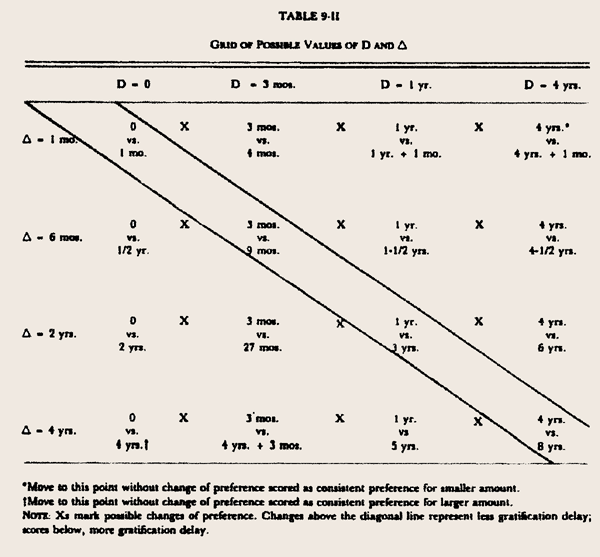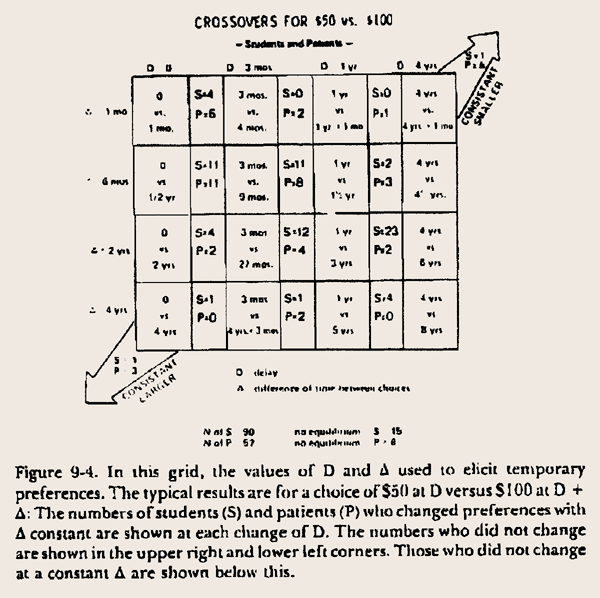`
Excerpt from
The motives of the will
George Ainslie and Varda Haendel
Published in E. Gottheil, K.A. Druley, T.E. Skoloda and H. Waxman, eds. Etiologic Aspects of Alcohol and Drug Abuse, 110-140. Springfield, IL, Charles C. Thomas.
![]()
Self-Reports of Temporary Preference
Procedure
To determine whether or not the steep, self-reported discount rates were more concave than simple percentage discount curves (i.e. exponential curves), we administered a questionnaire on hypothetical alternatives between various amounts of money at various delays. We asked forty-two university students and twenty-eight substance abuse patients to imagine that they had won a prize from a reliable company and asked their preference in a number of choices between a smaller amount prize money at delay D and an amount twice as great at delay D + Δ (See Table 9-11). To avoid asking every comparison on the table, a contingent sequence was followed.

After each question, if the subject preferred the smaller amount, D was gradually raised from zero to three months, and then, if he still preferred the smaller amount, to one year and then to four years. If the subject chose the larger amount at the first delay D, then Δ, the lag between the rewards was gradually raised from one month to six months, to two years, and to four years; if a subject then changed his preference to the smaller amount, Δ was held constant and D was increased in steps as was just described. The questioning for each pair of alternatives stopped with one of three outcomes: (1) when the subject changes his preference as a function of D, that is, while going from one choice to another on a horizontal line; (2) when a subject showed consistent preference for either the larger or the smaller amount, ending up either in the lower left or upper right-hand corner respectively; or (3) when a subject changed his preference only with changes of Δ, moving in an endless loop around two of the lines.*
We followed this contingent sequence four times, offering different amounts each time: $50 versus $100, $10 versus $20, $250 versus $500, and finally $50 versus $100 again for half of the subjects and for the other half $50 versus $100, $250 versus $500, $10 versus $20, and $50 versus $100 again. An additional 48 students and 29 patients were given the initial $50 prize at delay D versus $100 prize at delay D + Δ at the beginning of a different questionnaire.
Results

Figure 9-4 shows how students and patients responded to the first $50 versus $100 choice. Most subjects changed their preference as a function of D at some value of Δ. This was true of all the conditions and both groups of subjects as shown in Figure 9-5.

The students' curves are not significantly higher than the patients' by chi square. Furthermore, frequency of changing preference at low values of Δ and high values of D (i.e. X's above the diagonal band in Table 9-II) can be added to frequency of consistent preference for the small amount to form a rough general measure of impatience, and this is almost identical in patients (57%) and students (55%). As in the previous questionnaire, there is no tendency for patients to report a shorter holding of a savings bond (this time yielding 25 percent interest) (See Fig. 9-6). The lack of differences between the groups is striking in light of their great differences in age (19.7 vs. 38.5 years) and estimated length of education when completed (11.5 vs. 17.9 years of school), as well as their obvious differences in symptomatology.

* For instance, the subject might consistently choose $50 over $100 at all the delays shown in line C but prefer $100 to $50 at all the delays shown in line D. In this case, the subject would probably have changed his preference as a function of D if the increments in Δ had been smaller: If the grid in Figure 9-7 lacked the middle two lines, most subjects' answers would probably go around in a circle; conversely, if Δ were increased more gradually (i.e. more horizontal lines), the subjects who changed their preferences only when was changed would surely report changes of preferences while moving horizontally on one of these added lines. Nevertheless, we will report the data conservatively — not counting the endless loops as crossovers.




